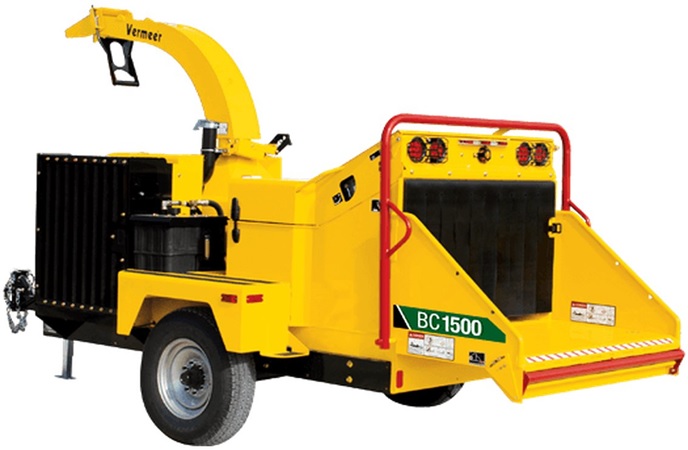Large chunks of wood can be reduced by wood chippers, which are strong machines, into smaller, easier-to-handle chips or mulch. They come in a range of sizes and shapes to meet various demands and are frequently used in landscaping, gardening, and construction tasks.
How do wood chippers operate then? Basically, a woodchipper chops up wood and other materials into tiny pieces using a sharp blade or direction drills. Some versions use electricity as their power source, while others use diesel or gasoline. The wood is fed into the machine by a hopper or chute, where it is cut into small chips or mulch that can be used for a number of tasks by the chipper’s internal blades.
Wood Chippers come in a variety of designs that are each intended for particular tasks. For instance, some models are made for commercial usage and can manage larger branches and heavier materials, while others are made for domestic use and can handle smaller branches and bits of wood. Aside from making beautiful mulch for playgrounds and walking paths, wood chippers can also be used to produce fuel for wood-fired boilers and other heating systems. Whether you’re a homeowner trying to enhance your yard or a contractor taking on a sizable building project, it’s simple to choose a machine that’s suitable for your needs given the wide variety of wood chippers on the market.
What Kind of Wood Chipper Are There?
Wood Chippers come in a variety of varieties, each created for a particular purpose or set of user requirements. Some of the most typical varieties are listed below:
1. Electric wood chippers
Compared to devices driven by gas or diesel, these electric wood chippers are often smaller and less powerful. They work well for processing small to medium-sized branches and twigs and are perfect for domestic use.
2. Gasoline-powered Woodchippers
Wood Chippers that use gasoline as their power source are more potent than those that use electricity. They are perfect for usage in expansive yards or on building sites since they can handle processing heavier branches and logs.
3. Diesel-Powered Woodchippers
The most potent kind of wood chipper, these machines run on diesel fuel. They can process big logs and other heavy materials, and are frequently employed in commercial settings.
4. Drum Wood Chippers
Wood Chippers with a drum-like form and blades positioned on the outside are referred to as drum wood chippers. They are more compact than other kinds of wood chippers and are frequently used for processing small-diameter wood.
5. Disc Wood Chippers
Aflat disc and blades positioned on the surface are referred to as “disc wood chippers.” They are more effective than drum wood chippers and are often used for cutting wood with a greater diameter.
6. Hand-fed Woodchippers
Are appropriate for processing modest amounts of wood because they are manually operated. They are perfect for homes that only need to process a modest amount of yard waste.
7. Self-Feeding Wood Chippers
These woodchippers include an internal feeder system that sucks in branches and other raw materials for processing automatically. They are perfect for commercial use because they are often more powerful than hand-fed devices.
What Purposes Does A Wood Chipper Serve?
Wood chippers are adaptable tools with a variety of applications, such as:
1. Gardening and Landscaping
Tree branches, leaves, and other yard debris are typically processed into mulch or wood chips using wood chippers. Then, this mulch can be utilised to improve the soil, stop weed development, and save water.
2. Land Clearing
By turning trees and other vegetation into wood chips, wood chippers can be used to clear land. This can assist in preparing the land for use in construction, farming, or other activities.
3. Fuel for Heating
Wood chips can be utilised as a renewable fuel source for heating appliances like wood-fired boilers. An economical and environmentally beneficial replacement for conventional heating techniques is this.
4. Animal Bedding
In stables and other agricultural settings, wood chips can be used as animal bedding. The chips offer livestock and other animals a cosy and absorbent bedding material.
5. Playground Surface
Wood chips can be utilised as a durable and secure playground surface in parks and other public spaces. The chips absorb shock from falls and are weather- and wear-resistant.
6. Decorative Landscaping
Wood chips can be used in landscaping as a decorative component, such as for paths, garden borders, or around trees and shrubs.
7. Paper and Pul[p Production
Wood chips are a crucial raw material used in the manufacture of paper and pulp. They undergo processing to create pulp, which is used to create a variety of paper products.
For anyone who needs to process wood and other vegetation, including farmers, landscapers, and other professionals, wood chippers are a useful equipment. They offer a quick and effective way to recycle yard waste, clear land, and create beneficial materials for many uses.
Conclusion
In order to turn wood and other plants into useful materials like mulch, fuel, animal bedding, and playground surfaces, wood chippers are a necessary tool. For every need, from personal landscaping to commercial land clearing, there is a wood chipper available on the market in a variety of types and sizes. Users can take advantage of this adaptable machine’s ease, efficacy, and affordability by picking the proper kind of wood chipper. A wood chipper, whether used for domestic or commercial purposes, can aid in trash reduction, enhance soil quality, and promote sustainable business practices.



